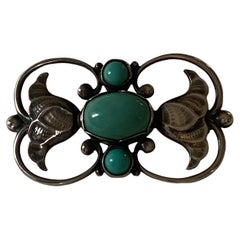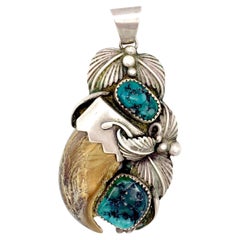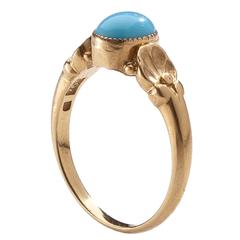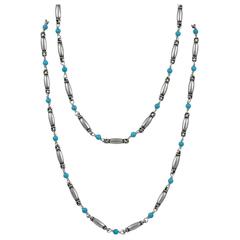Georg Jensen Turquoise
Late 20th Century Danish Brooches
Sterling Silver
Vintage 1910s Danish Art Nouveau Pendant Necklaces
Turquoise, Silver
Recent Sales
20th Century Danish Art Nouveau More Rings
Turquoise, 18k Gold
20th Century Danish Arts and Crafts Link Necklaces
Turquoise, Sterling Silver
20th Century Danish Romantic Link Necklaces
Turquoise, Silver
Vintage 1950s Danish Brooches
20th Century Danish Beaded Necklaces
Turquoise, Sterling Silver
Vintage 1950s Danish Art Nouveau Dangle Earrings
Turquoise, Sterling Silver
Vintage 1950s Danish Art Nouveau Dangle Earrings
Turquoise, Sterling Silver
Vintage 1950s Danish Art Nouveau Brooches
Turquoise, Sterling Silver
Vintage 1950s Danish Art Nouveau Brooches
Turquoise, Sterling Silver
Mid-20th Century Danish Modern Brooches
Turquoise, Sterling Silver
20th Century Danish More Rings
Turquoise, Sterling Silver
20th Century Danish Link Bracelets
Turquoise, 18k Gold
Mid-20th Century Danish Modern Link Bracelets
Turquoise, Silver
Mid-20th Century Danish Modern More Rings
Turquoise, 14k Gold
People Also Browsed
2010s Thai Artisan Stud Earrings
Chalcedony, Blue Sapphire, Gold, 14k Gold, Yellow Gold
20th Century Danish Art Nouveau Brooches
Antique 1890s European Victorian Drop Necklaces
Diamond, Opal, 18k Gold, Silver
Vintage 1970s Danish Modernist More Jewelry
Agate, Sterling Silver
2010s Danish Contemporary Multi-Strand Necklaces
Silver
Antique 1880s English Art Nouveau Brooches
Opal, Black Opal, Diamond, White Diamond, Gold, 18k Gold, Yellow Gold, S...
20th Century Danish Art Nouveau Cocktail Rings
Moonstone, Silver, Sterling Silver
20th Century Danish Romantic Cluster Rings
Moonstone, Sterling Silver
21st Century and Contemporary Spanish Art Nouveau Fashion Rings
Diamond, 18k Gold, Yellow Gold, Enamel
20th Century Danish Modern Link Necklaces
Sterling Silver
Antique 1890s German Art Nouveau Pendant Necklaces
Opal, Silver, Enamel
Antique 1890s Austrian Art Nouveau Pendant Necklaces
Diamond, White Diamond, Pearl, Natural Pearl, Ruby, Gold, 18k Gold, Yell...
Antique Early 1900s Austrian Art Nouveau Pendant Necklaces
Silver, Enamel
Vintage 1960s Danish Modern Cocktail Rings
Moonstone, Gold, 18k Gold
Antique 1890s British Arts and Crafts Pendant Necklaces
Pearl, Sterling Silver, Enamel
Vintage 1930s Danish Art Nouveau Link Necklaces
Lapis Lazuli, Sterling Silver
Georg Jensen Turquoise For Sale on 1stDibs
How Much is a Georg Jensen Turquoise?
Georg Jensen for sale on 1stDibs
For over a century, Georg Jensen has produced some of the finest objects in Scandinavian modern design, including silver tableware, serving pieces, home decor, jewelry and more, frequently partnering with leading artisans to expand its offerings and respond to shifting tastes. Known for minimal aesthetics that reference nature, the craftsmanship of this legendary Danish silverware firm has regularly married function with thoughtful and beautiful design.
Founder Georg Jensen (1866–1935) was born in the small town of Radvaad, Denmark, and began his training as a goldsmith at 14. After studying sculpture and then training with master silversmith Mogens Ballin, he established his own silver business in Copenhagen in 1904. By 1918, the company was successful enough to open a shop in Paris.
Jensen’s firm produced an incredibly vast range of silver objects, from serving dishes and barware to centerpieces and chandeliers. For his early work, which bore ornate floral details and other organic forms of Art Nouveau, Jensen looked to the splendors of the natural world. The 1905 Blossom teapot, for instance, was topped with a magnolia bud and deftly balanced on toad feet, while some of Jensen’s best-known flatware patterns included Lily of the Valley, introduced in 1913, and Acorn, which debuted in 1915.
Collaboration with outside designers, long before such partnerships were common in design, would lead to some of the company’s most popular and enduring work of the mid-century. Sigvard Bernadotte and Vivianna Torun Bülow-Hübe created collections, as did Henning Koppel, whose curvy 1952 Pregnant Duck pitcher is a Georg Jensen classic.
After evolving and expanding throughout the 20th century, Georg Jensen was acquired by Investcorp in 2012. Today, the company is a global luxury brand with more than 1,000 stores around the world. It continues to produce seductive new pieces, such as a tea service made with Marc Newson in 2015, as well as timeless heritage designs, including the relaunch in 2019 of the 1018 solid sterling-silver Tureen 270. In 2020, the firm introduced the Jardinière 1505. Sculptural and richly decorative, the never-before-realized showpiece is hand-hammered from sheets of the finest sterling silver and is based on a 1915 sketch from Jensen’s archives.
Find an exquisite collection of Georg Jensen serveware, ceramics, silver and glass today on 1stDibs.
The Legacy of Turquoise in Jewelry Design
The thought of vintage and antique turquoise jewelry often conjures up images of striking Navajo bracelets and necklaces worn with a denim shirt and cowboy boots. This all-American look has been celebrated by fashion designers like Ralph Lauren and Tommy Hilfiger on their runways and in ad campaigns. In the October 2016 issue of Vogue magazine, Tom Ford said he only wears turquoise jewelry at his Santa Fe ranch. So what is it about this gorgeous blue-green stone that makes us wish that we were born in December?
It’s not surprising that turquoise is abundant in New Mexico and Arizona because, according to the Gemological Institute of America (GIA), it needs to be in “dry and barren regions where acidic, copper-rich groundwater seeps downward and reacts with minerals that contain phosphorus and aluminum.
Turquoise is not found in a single crystal but is a combination of microcrystals. Its appearance, waxy and opaque, is attributed to its structure and composition. “It’s an aggregate of microscopic crystals that form a solid mass. If the crystals are packed closely together, the material is less porous, so it has a finer texture. Fine-textured turquoise has an attractive, waxy luster when it’s polished. Turquoise with a less-dense crystal structure has higher porosity and coarser texture, resulting in a dull luster when it’s polished,” notes the GIA. Since no one wants to set a dull piece of turquoise, porous turquoise is often treated to make the stone more attractive.
In the United States, there have been discoveries of turquoise from 200 B.C. It is not just loose turquoise stones that have been found, but entire suites of jewelry from prehistoric times. In the late 19th-century, the Navajo Indians, who learned silversmithing from the Spanish, started to make beads out of turquoise and eventually combined it with silver around the 1880s. Initially this jewelry was for ceremonial purposes, but it became fashionable once the tourism in the Southwest picked up in the beginning of the 20th century.
Find antique and vintage turquoise rings, necklaces, bracelets and other accessories on 1stDibs.
Read More
5 Fantastic Jewelry Finds, from the 19th Century to Now
Jewelry historian Vanessa Cron combed 1stDibs and selected some dazzling pieces with timeless appeal.
Jacqueline Rabun’s Fluid, Minimalist Jewelry Designs Are Inspired by Life Experiences
Motherhood is one of the influences that has shaped the longtime Georg Jensen collaborator's quietly powerful creations.



